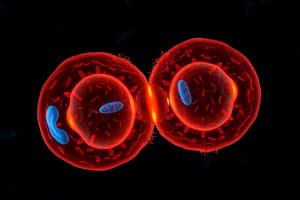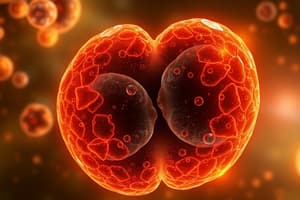Podcast
Questions and Answers
What is one key difference between meiosis and mitosis in terms of chromosome number?
What is one key difference between meiosis and mitosis in terms of chromosome number?
- Meiosis produces genetically identical cells, while mitosis produces genetically varied cells.
- Meiosis produces diploid cells, while mitosis produces haploid cells.
- Meiosis results in four daughter cells, while mitosis results in two daughter cells. (correct)
- Mitosis involves two rounds of division, while meiosis involves one.
During which stage of meiosis do sister chromatids separate?
During which stage of meiosis do sister chromatids separate?
- Metaphase I
- Telophase I
- Anaphase II (correct)
- Prophase I
How do the cells produced by females during meiosis differ from those produced by males?
How do the cells produced by females during meiosis differ from those produced by males?
- Female cells have more DNA than male cells.
- Females produce diploid cells, while males produce haploid cells.
- All female cells are equal in size, while male cells are of different sizes.
- Males produce four equal-sized sperm cells, while females typically produce one egg and three polar bodies. (correct)
Which statement accurately describes the genetic variation of daughter cells produced from meiosis?
Which statement accurately describes the genetic variation of daughter cells produced from meiosis?
What is the significance of polar bodies produced during female meiosis?
What is the significance of polar bodies produced during female meiosis?
What is the primary outcome of mitosis?
What is the primary outcome of mitosis?
Which statement accurately describes meiosis?
Which statement accurately describes meiosis?
Which process is described by the joining of sperm and egg cells?
Which process is described by the joining of sperm and egg cells?
What characteristic of the cells produced by meiosis distinguishes them from those produced by mitosis?
What characteristic of the cells produced by meiosis distinguishes them from those produced by mitosis?
What was Gregor Mendel's primary contribution to genetics?
What was Gregor Mendel's primary contribution to genetics?
What type of pollination occurs when sperm cells fertilize egg cells within the same flower?
What type of pollination occurs when sperm cells fertilize egg cells within the same flower?
What outcome results from self-pollination in plants?
What outcome results from self-pollination in plants?
Which statement about true-breeding pea plants is correct?
Which statement about true-breeding pea plants is correct?
What is the primary purpose of meiosis?
What is the primary purpose of meiosis?
What event occurs during Prophase I of meiosis?
What event occurs during Prophase I of meiosis?
How does crossing-over during meiosis impact genetic diversity?
How does crossing-over during meiosis impact genetic diversity?
During which phase of meiosis are homologous chromosomes pulled to opposite ends of the cell?
During which phase of meiosis are homologous chromosomes pulled to opposite ends of the cell?
What is a result of the random alignment of homologous chromosomes during Metaphase I?
What is a result of the random alignment of homologous chromosomes during Metaphase I?
Flashcards
Meiosis
Meiosis
A cell division process resulting in four haploid cells from one diploid cell.
Tetrad
Tetrad
A structure formed when a homologous chromosome pairs up during meiosis I.
Crossing-over
Crossing-over
The exchange of chromosome segments between homologous chromosomes during meiosis.
Homologous Chromosomes
Homologous Chromosomes
Signup and view all the flashcards
Meiosis II
Meiosis II
Signup and view all the flashcards
Diploid
Diploid
Signup and view all the flashcards
Haploid
Haploid
Signup and view all the flashcards
Gamete
Gamete
Signup and view all the flashcards
Fertilization
Fertilization
Signup and view all the flashcards
True-breeding
True-breeding
Signup and view all the flashcards
Self-pollination
Self-pollination
Signup and view all the flashcards
What happens during Telophase I?
What happens during Telophase I?
Signup and view all the flashcards
What makes Meiosis I different from Meiosis II?
What makes Meiosis I different from Meiosis II?
Signup and view all the flashcards
What are the products of Meiosis II?
What are the products of Meiosis II?
Signup and view all the flashcards
What is the difference between male and female gametes?
What is the difference between male and female gametes?
Signup and view all the flashcards
What makes meiosis different from mitosis?
What makes meiosis different from mitosis?
Signup and view all the flashcards
Study Notes
Introduction to Genetics
- Mendel's experiments with pea plants laid the foundation for the study of heredity.
- He used true-breeding plants (plants that would produce offspring identical to themselves).
- Mendel cross-pollinated plants with different characteristics to produce seeds with two different parents.
- This process is called cross-pollination.
- He studied different pea plant traits like seed shape and color, pod shape and color, flower position of the plant, and plant height.
- Each trait had two contrasting characters (e.g., round or wrinkled seeds, yellow or green seeds).
- The original pair of true-breeding plants is called the P (parental) generation and the offspring are called the F1 (first filial) generation.
- Each trait Mendel studied was controlled by one gene. Genes come in different versions called alleles.
- Mendel used this to form the four principles of inheritance.
Mendelian Genetics principles
- The first concept is that alternative versions of genes account for variations in inherited characters. These alternative versions are called alleles.
- For each character, an organism inherits two alleles, one from each parent. The two alleles at a locus on a chromosome may be identical (homozygous) or different (heterozygous).
- If the two alleles at a locus differ, then one (dominant allele) determines the organism's appearance, and the other (recessive allele) has no noticeable effect on appearance.
- The Law of Segregation states that the two alleles for a heritable character separate (segregate) during gamete formation and end up in different gametes.
Non-Mendelian Inheritance
- Some alleles are neither dominant nor recessive, and some traits are controlled by multiple alleles or multiple genes.
- Incomplete dominance occurs when one allele is not completely dominant over another. In this case, the offspring heterozygous phenotype is between the two homozygous dominant parents.
- Codominance occurs when both alleles are expressed completely.
- Multiple alleles occur when a gene has more than two alleles.
Polygenic Inheritance
- Traits controlled by two or more genes are called polygenic traits.
- The genes for a polygenic trait may be scattered along the same chromosome or located on different chromosomes.
- Due to independent assortment and crossing-over during meiosis, many different combinations appear in offspring.
Meiosis
- Gametes are formed by the process of meiosis, which divides a diploid cell (having two sets of chromosomes) into four haploid cells (having one set of chromosomes).
- Meiosis involves two divisions: meiosis I and meiosis II.
- During meiosis I, homologous chromosomes pair and exchange genetic material (crossing over).
Mitosis
- Mitosis creates genetically identical cells, maintaining the same number of chromosomes and alleles as the original cell. It's used for growth and repair.
Other Concepts
- Fertilization: The process where sperm and egg cells join to create a new cell called a zygote.
- Punnett Square: A diagram used to predict the outcome of a genetic cross.
- Genotype: The set of alleles an individual has for a trait.
- Phenotype: The physical appearance of a trait.
- Heterozygous: Having two different alleles for a trait.
- Homozygous: Having two identical alleles for a trait.
Human Blood Types
- Blood type is an example of multiple allele inheritance, with three alleles (IA, IB, i) determining the four possible phenotypes (A, B, AB, and O).
Studying That Suits You
Use AI to generate personalized quizzes and flashcards to suit your learning preferences.



